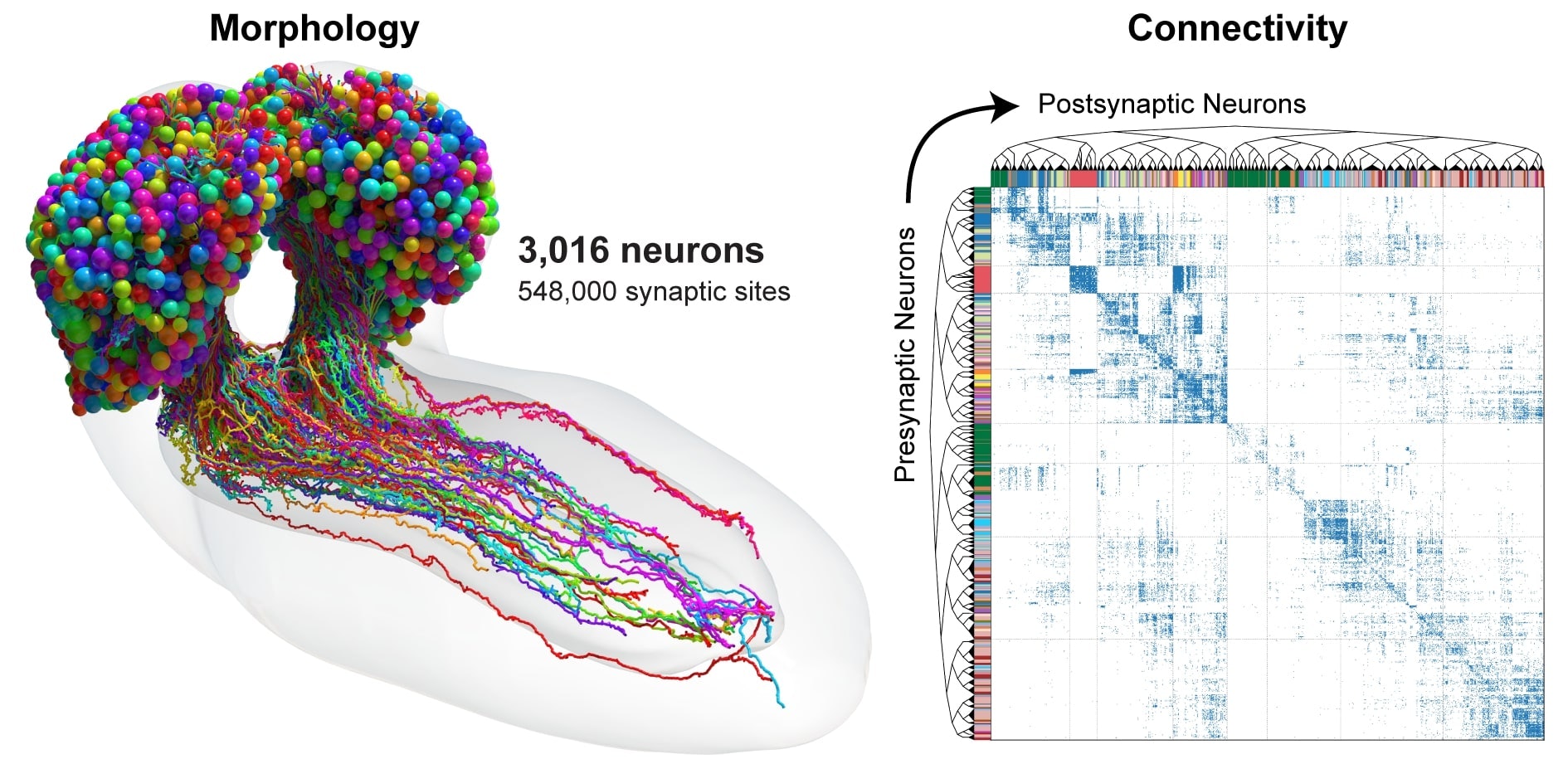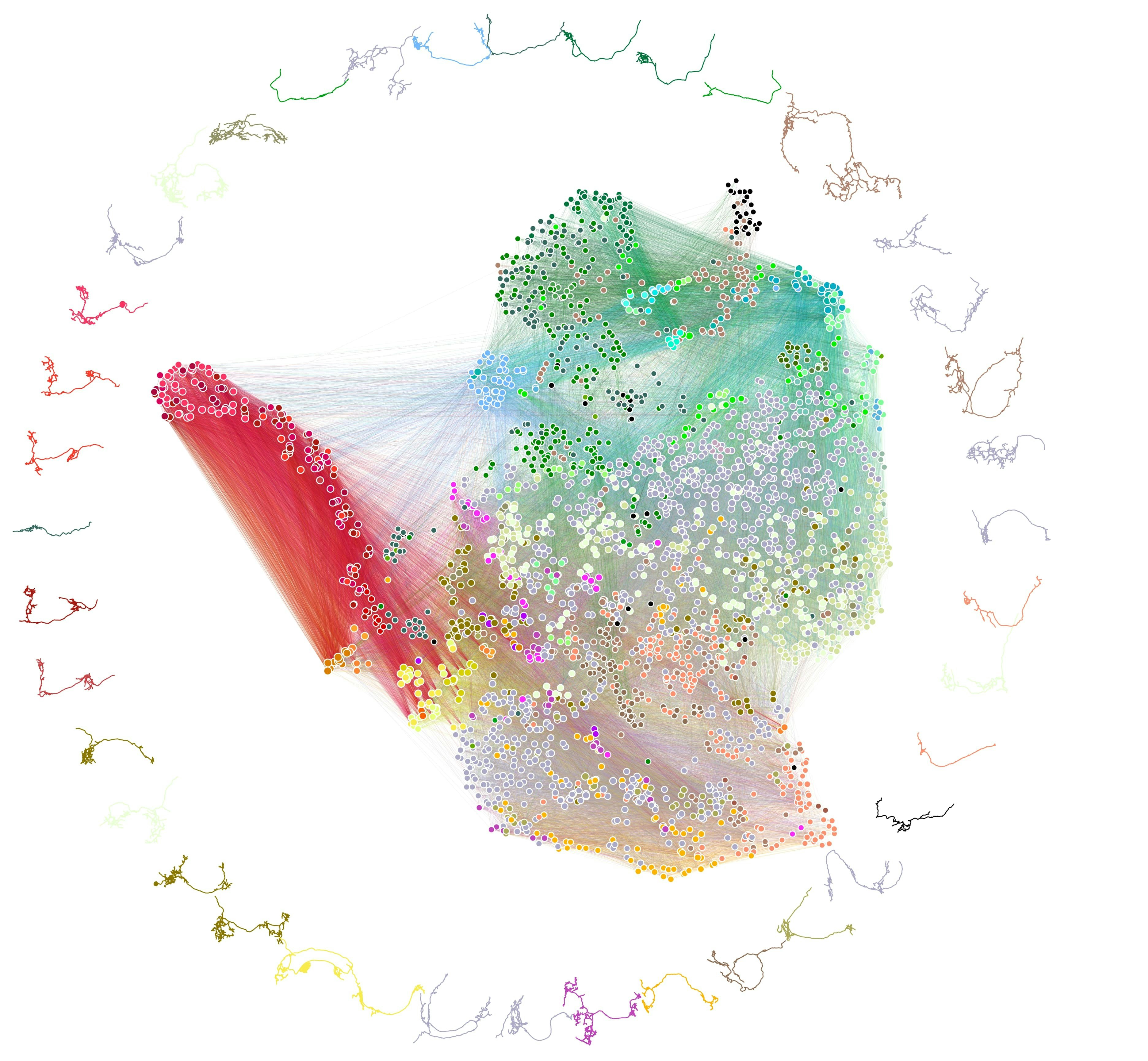
Have you ever wondered what a fruit fly thinks about? Perhaps it ponders how often to buzz by your ear or where the optimal landing place is on your slice of watermelon. The contents of Drosophila melanogaster’s thoughts remain a mystery, but neuroscientists and bioengineers from Johns Hopkins University and the University of Cambridge are beginning to understand the neural pathways underpinning its every move.
In a study out this week in the journal Science, the team of researchers reconstructed a baby fruit fly’s brain, neuron by neuron, and the possible highways between those brain cells. This map is called a connectome, and it’s the first time researchers have achieved this with a fruit fly. The new chart of neural connections could even reveal something about our own minds and behavior, the authors of the paper say.

Opening the black box
The fruit fly larva marks the fourth-ever organism to have its neural network mapped. Previously, researchers mapped the brain connections of a nematode, a tadpole larva, and a worm. It also marks the largest connectome to date, though you wouldn’t know by looking at it. The baby fruit fly’s brain, at 170 by 100 by 70 micrometers, contains 3,016 neurons. The space between neurons is called the synapse, and when one neuron bolts an electrical impulse to another, that creates a synaptic connection. This is how neurons communicate with each other, creating whole circuits that comprise thoughts and actions. The team painstakingly plotted 548,000 synaptic connections. The challenge now is understanding how the many precise permutations of pathways connecting various neurons confer behavior.
“All brains are networks of interconnected neurons, but we don't really know what the structure of these networks is,” senior author Marta Zlatic tells Inverse. Zlatic is a neuroscientist at the University of Cambridge. Understanding the structure brings us closer to understanding how brain activity translates to behavior.
Brains — drosophila and otherwise — take in sensory information and, in response, send signals that translate into motor function and behavior. But the step between input and output is an opaque black box. “We can study behavior and make some guesses about what this black box is actually doing, but fundamentally, there are neural circuits organized in a very specific way that connect our sensors to our motor systems,” says co-author Albert Cardona, a neurobiology researcher at the University of Cambridge.
By mapping the connectome, the team was able to plot every single neuron along with every single synaptic connection. This map demonstrates the lightning-fast processes zapping through a baby fruit fly's brain as it responds to stimuli like sound and smell.
The fruit fly in us
This connectome represents a number of benchmarks. For one, it’s a step toward mapping neural networks of more complex organisms. In 1986, scientists mapped the central nervous system of the nematode, Caenorhabditis elegans. Then, in 2016, researchers published the connectome of a tadpole larva, Ciona intestinalis. Most recently, in 2020, scientists created a model of the larval annelid worm Platynereis dumerilii’s brain. But these are much simpler structures than the fruit fly larva’s brain.
In fact, depending on whom you ask, the baby fruit fly is the first organism whose connectome has been mapped that actually qualifies as a brain.
“Arguably, it’s the first brain,” co-author Joshua “Jovo” Vogelstein, a biomedical engineer at Johns Hopkins University, tells Inverse. “C. elegans doesn't really have a brain separate from a peripheral nervous system. It's just a bunch of nerves.” The peripheral nervous system generally mediates sensory information from the outside world and controls involuntary processes like blood pressure. Still, a system of nerves isn’t the same as a connectome crackling with neural circuits, integrating huge amounts of information with every choice. So while this paper may detail a connectome from the fourth-ever organism, this may be the first one that counts as a brain.
Fruit flies are also model organisms for studying human conditions. Humans and fruit flies have about 60 percent of their genetic material in common, so these insects are a good starting point to study everything from decision-making to cancer. Thanks to millennia of evolution perfecting the brain across species, these neural pathways resemble those of humans, albeit on a much simpler level. “They're not randomly connected at all,” Zlatic tells Inverse, “but evolution has carefully shaped them to be suitable for the whole range of different computations and functions,” Zlatic says these connections are conserved across species, meaning that brains evolved with similar foundations in other species as they grew more complex. Human brains — with their 100 billion neurons and trillions of synaptic connections — have many capacities that flies lack, but both have a foundation in common.
One of these functions includes thought. Baby fruit flies probably don’t think, but their connectome “is kind of like a blueprint” for all the thinking humans do, according to Vogelstein. Ultimately, Vogelstein hopes connectomes can reveal the “mechanisms of enlightenment” that make humans contemplative beings.
To map a brain
Beginning in 2012, the Cambridge team started by looking at the baby fruit fly brain in an electron microscope, which renders high-resolution images of infinitesimally small structures by using electrons as an illumination source. Then, to create the connectome, they first traced, by hand, every single neuron and its synaptic connections. Then, using a computer, the team painstakingly plotted each of the 3,016 neurons, going at the rate of one neuron per day. Then came the work of drawing the 548,000 synaptic connections. In total, it took the group around seven years.
In 2019, Vogelstein began analyzing the hundreds of thousands of synaptic connections to find the most meaningful ones. It turns out there were a number of intriguing connections. As a primer, a neuron comes down to two parts: axon and dendrite. A textbook synaptic connection flows from axon to dendrite, but these researchers saw synapses that went against the grain.
“They were axon-to-axon connections, or dendrite-to-dendrite connections, or dendrite-to-axon connections,” says co-author Michael Winding, a zoology research associate at the University of Cambridge. What’s more, statistical analysis revealed classical axon-to-dendrite connections comprised only about half of the synaptic connections. Winding says nearly 46 percent were these “noncanonical sorts,” whereas he’d been expecting the vast majority of them to be axon-dendrite links. The next step is understanding how these connections differ.
Zlatic also notes that neurons driving learning received the most feedback in a neural circuit. Some brain cells only register input from sensations, but others take in all kinds of information. “It is this output that influences future learning,” she says.

The path forward
As a single neuron connects to a web of other cells by various pathways, this milestone branches out toward many different futures of research.
One path leads to the connectomes of more complex organisms. A mature fruit fly is the logical next step, but beyond that, we have rodents, primates, and, eventually, humans.
This research also lends itself to studying neuropsychiatric disorders. In fact, next month, Winding is leaving the University of Cambridge to start a research group at the Francis Crick Institute, where he will look at how conditions like autism spectrum disorder manifest through synaptic connections. “Then we can understand how computations in the brain change, particularly computations that are important for social behaviors,” he tells Inverse.
Building a brain neuron by neuron is also useful for making better artificial intelligence. Now that we see the neurons related to learning are the most recurrent, that will help engineers build A.I. that can incorporate all kinds of information into its learning. “As we converge into finding these great architectures, we need to start thinking about how powerful are these A.I. models,” Winding says.
It may be hard to see what we have in common with fruit fly larvae, but they hold the key to understanding our own minds.







